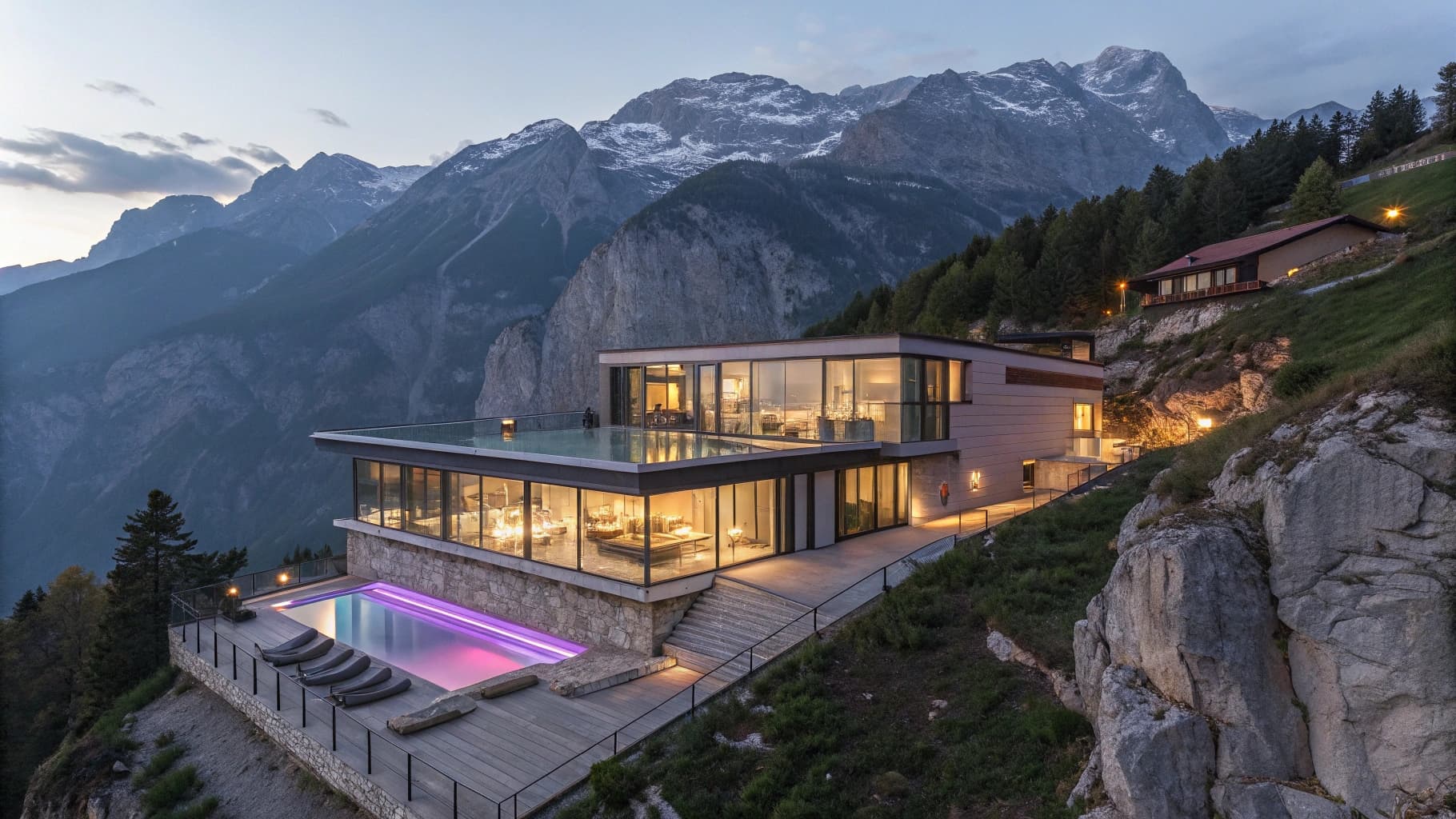Mountain retreats have undergone a significant transformation over the centuries, evolving from simple shelters to luxurious havens that blend seamlessly with their natural surroundings. Historically, these retreats served as basic lodgings for hunters and travelers seeking refuge from the elements. Early structures were often rudimentary, constructed from local materials such as timber and stone, designed primarily for functionality rather than aesthetics.
As society progressed, the concept of a mountain retreat began to shift, influenced by the Romantic movement of the 18th and 19th centuries, which celebrated nature and the sublime beauty of the wilderness. This period saw the emergence of more elaborate cabins and lodges, often adorned with intricate woodwork and expansive porches that invited guests to immerse themselves in the breathtaking landscapes. In the 20th century, the rise of leisure travel and the growing appreciation for nature led to a new wave of mountain retreats that catered to affluent clientele.
Architects began to design properties that not only provided comfort but also showcased the stunning vistas that surrounded them. The introduction of modernist principles brought about a focus on clean lines and open spaces, allowing for a harmonious relationship between indoor and outdoor environments. Today, mountain retreats are often characterized by their innovative designs that prioritize sustainability and environmental stewardship while offering luxurious amenities.
This evolution reflects a broader cultural shift towards valuing experiences in nature, leading to a resurgence in interest for mountain getaways that provide both solace and adventure.
Incorporating Natural Elements into Modern Design
Natural Materials and Aesthetic Appeal
Designers often utilize materials such as reclaimed wood, stone, and glass to create spaces that resonate with the landscape. For instance, large glass panels can be strategically placed to frame views of majestic peaks or serene forests, blurring the lines between indoor and outdoor living.
Sustainability and Ecological Footprint
The use of natural materials extends beyond mere aesthetics; it also contributes to the overall sustainability of the retreat. By sourcing materials locally, architects can reduce transportation emissions and support regional economies. Additionally, incorporating elements like living roofs or green walls can improve insulation and promote biodiversity, further enhancing the retreat’s ecological footprint.
Harmonious Balance and Luxury
The thoughtful integration of these natural components creates a harmonious balance between human habitation and the wilderness, ensuring that mountain retreats remain respectful of their surroundings while providing a luxurious escape for their inhabitants.
Maximizing Views and Natural Light
One of the primary goals in designing mountain retreats is to maximize views and natural light, creating an inviting atmosphere that draws occupants into the beauty of their surroundings. Architects often employ various strategies to achieve this objective, such as orienting windows and outdoor spaces to capture panoramic vistas. For example, a well-placed deck or balcony can serve as an ideal vantage point for sunrise or sunset views, allowing residents to fully appreciate the changing colors of the sky against a backdrop of rugged mountains.
Natural light plays a crucial role in enhancing the ambiance of mountain retreats. Large windows not only flood interiors with sunlight but also create a sense of openness and spaciousness. Skylights are another effective design element that can illuminate darker areas of a home while providing glimpses of the sky above.
In addition to aesthetic benefits, maximizing natural light can also contribute to energy efficiency by reducing reliance on artificial lighting during daylight hours. By thoughtfully considering sightlines and light sources, architects can create spaces that feel both expansive and intimate, allowing occupants to connect with nature in meaningful ways.
Sustainable Practices in Mountain Retreat Design
Sustainability has become an essential consideration in the design of mountain retreats, reflecting a growing awareness of environmental issues and a desire to minimize ecological impact. Many architects are now prioritizing energy-efficient designs that incorporate renewable energy sources such as solar panels or wind turbines. These technologies not only reduce reliance on fossil fuels but also provide homeowners with greater energy independence in remote locations where traditional power sources may be limited.
In addition to energy efficiency, sustainable practices in mountain retreat design often include water conservation strategies. Rainwater harvesting systems can be implemented to collect and store rainwater for irrigation or non-potable uses, while low-flow fixtures can help reduce water consumption within the home. Furthermore, careful site selection is crucial; building on previously disturbed land or utilizing existing infrastructure can help preserve natural habitats and minimize disruption to local ecosystems.
By embracing these sustainable practices, mountain retreats can serve as models for responsible living in harmony with nature.
Balancing Comfort and Functionality in Remote Locations
Designing mountain retreats requires a delicate balance between comfort and functionality, particularly in remote locations where access to resources may be limited. Comfort is paramount; after all, these retreats are intended as sanctuaries where individuals can unwind and rejuvenate. Thoughtful interior layouts that prioritize cozy living spaces—complete with fireplaces, plush furnishings, and inviting communal areas—are essential for creating an atmosphere conducive to relaxation.
However, functionality must not be overlooked. In many cases, mountain retreats are situated in areas prone to harsh weather conditions or challenging terrain. Therefore, architects must consider practical elements such as efficient heating systems, durable materials that withstand the elements, and layouts that facilitate easy movement throughout the space.
For instance, mudrooms equipped with storage for outdoor gear can help maintain cleanliness within the home while providing convenient access to equipment needed for hiking or skiing adventures. By harmonizing comfort with practicality, designers can create mountain retreats that cater to both leisure and adventure.
Integrating Technology into Secluded Environments
Smart Home Technology: Convenience at Your Fingertips
Smart home technology has emerged as a solution that allows homeowners to control various aspects of their retreat from afar—whether it’s adjusting heating settings before arrival or monitoring security systems through mobile applications.
Sustainable Living in Harmony with Nature
Advancements in renewable energy technology have made it feasible for mountain retreats to operate independently from traditional power grids. Off-grid solar systems can provide reliable electricity while minimizing environmental impact, allowing residents to enjoy modern amenities without compromising their commitment to sustainability.
Staying Connected in Remote Areas
speed internet access has become more accessible in remote areas due to advancements in satellite technology, enabling occupants to stay connected while still enjoying the tranquility of nature. This fusion of technology with rustic charm creates an environment where individuals can fully embrace both comfort and adventure.
Creating Cozy and Inviting Spaces in Mountain Retreats
The essence of a mountain retreat lies in its ability to provide warmth and comfort amidst breathtaking natural beauty. Creating cozy and inviting spaces is paramount in achieving this goal; designers often focus on incorporating elements that evoke feelings of warmth and relaxation. Textiles play a significant role in this endeavor—soft throws, plush rugs, and comfortable seating arrangements can transform a stark space into an inviting haven where occupants feel at ease.
Fireplaces are another quintessential feature of mountain retreats that contribute to their cozy ambiance. Whether traditional wood-burning stoves or modern gas fireplaces, these focal points not only provide warmth but also serve as gathering spots for family and friends. The flickering flames create an atmosphere conducive to storytelling or simply enjoying quiet moments together after a day spent exploring the outdoors.
By thoughtfully curating furnishings and design elements that prioritize comfort, architects can craft spaces that invite occupants to unwind and savor their surroundings.
Embracing Minimalism and Clean Lines in Mountain Retreat Design
In recent years, there has been a notable shift towards minimalism in mountain retreat design—a trend characterized by clean lines, uncluttered spaces, and an emphasis on functionality over excess. This design philosophy aligns well with the serene landscapes that surround these retreats, allowing nature itself to take center stage without distraction from ornate decor or unnecessary embellishments. Minimalist designs often feature open floor plans that promote fluidity between spaces while maximizing natural light.
The use of neutral color palettes further enhances this minimalist approach; earthy tones inspired by the surrounding environment create a calming atmosphere that complements rather than competes with nature’s beauty. Additionally, furniture choices tend to favor simplicity—pieces that are both aesthetically pleasing and functional without overwhelming the space. By embracing minimalism in mountain retreat design, architects can create environments that foster mindfulness and appreciation for both the built environment and its natural context.
FAQs
What is a mountain retreat?
A mountain retreat is a place located in a mountainous area that offers a peaceful and secluded environment for relaxation and recreation.
How do mountain retreats blend with modern design?
Mountain retreats blend with modern design by incorporating contemporary architectural elements, clean lines, and minimalist aesthetics while still maintaining a connection to the natural surroundings.
What are some common features of modern mountain retreats?
Common features of modern mountain retreats include large windows to maximize natural light and views, open floor plans, sustainable materials, and outdoor living spaces such as decks and patios.
How do modern mountain retreats incorporate sustainability?
Modern mountain retreats incorporate sustainability by using eco-friendly materials, energy-efficient systems, and passive design strategies to minimize their environmental impact and harmonize with the natural surroundings.
What are the benefits of staying at a modern mountain retreat?
The benefits of staying at a modern mountain retreat include experiencing a tranquil and serene environment, enjoying outdoor activities such as hiking and skiing, and immersing oneself in a contemporary yet nature-inspired living space.

